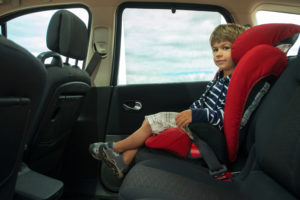How often do people say that they are really excited when they barely met the minimum requirements for something? Safety is definitely not a place where we should just be meeting the minimum requirements. When you are looking for a car, do you pick one with a minimum safety rating? Do you choose a bike helmet that is “good enough”? So why do people think that the minimum height and weight requirements for car seats are just fine? One of the reasons may be that parents are excited for their little one to meet another milestone. They are moving to a booster seat! Yay! “Don’t they look so cute?” Another reason is convenience. The seat belt booster will be quicker at pick up and drop off. The box on the car seat says that they have to be AT LEAST 40 pounds. “My child is 40 pounds! It’s time!” Why is the minimum okay for our children? When has it ever been okay? In a world where parents stress about making sure their children eat organic food and don’t have too much screen time, why oh why are we not keeping our kids as safe as possible in the car? Kids are far more likely to die in a car accident than to die because their chicken nugget wasn’t from an antibiotic-free chicken.
I get it. Throwing a booster seat in the car and calling it a day is way easier than installing a car seat. Car seats are a huge pain. I LOATHE installing car seats. Installing a car seat is like getting in a full cardio workout. When you have to install three, you may as well have run a marathon. I have cut my hands installing car seats. I’ve hit my head on the door frame. I have knelt on toys. It’s basically abuse. By the time you are finished, you’re sweating like crazy, and your language is not for little ears. If they didn’t have the ability to save the life of the most precious gift I have ever been given, I wouldn’t use them. However, they do. They save lives. They keep children safe in accidents where the vehicle is unrecognizable.
Recently there was a news story about a little girl who was permanently injured when in a high-back seat belt booster seat during a car accident. Her parents had put her in this seat because she had met the minimum requirements and the box said it was safe. Sadly, the parents were misinformed. Parents today aren’t getting enough information about proper car seat use. They are only getting the information they are reading on the box or in the car seat manual. When you turn 16, reading the manual of the car doesn’t mean you know how to drive it. It is so vital that we help our fellow parents learn more about car seats. I wouldn’t know any of this if it weren’t for a mom’s group on Facebook. The information I learned from that group may have saved my child’s life.

So to help my fellow parents out, here are some essential facts from the American Association of Pediatrics:
- Infants and toddlers should ride in a rear-facing car safety seat as long as possible until they reach the highest weight or height allowed by their seats. Most convertible seats have limits that will enable children to ride rear-facing for two years or more.
- Once they are facing forward, children should use a forward-facing car safety seat with a harness for as long as possible, until they reach the height and weight limits for their seats. Many seats can accommodate children up to 65 pounds or more.
- When children exceed these limits, they should use a belt-positioning booster seat until the vehicle’s lap and shoulder seatbelt fits properly. Usually, this is when they have reached at least 4 feet 9 inches in height and are 8 to 12 years old.
- When children are old enough and large enough to use the vehicle seat belt alone, they should always use lap and shoulder seat belts for optimal protection.
- All children younger than 13 years should be restrained in the rear seats of vehicles for optimal protection.










